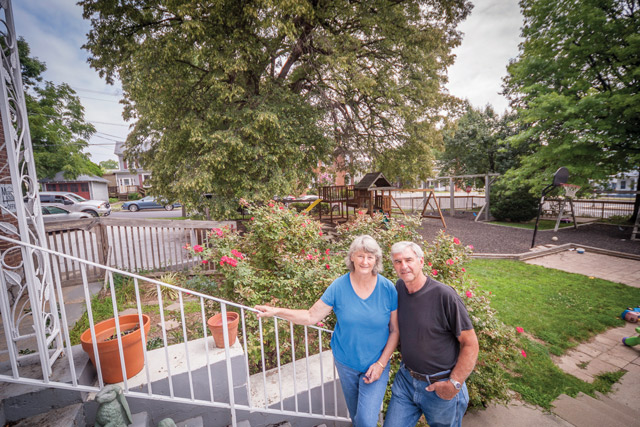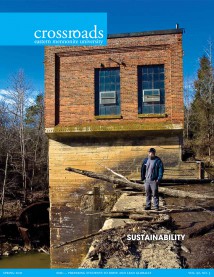
Phyllis and Roy Early, both 1970 graduates, organized a group of concerned local citizens in the late 1908s to address the issue of homelessness in EMU’s home region. The result was Mercy House. Photo by Michael Sheeler
Soon after graduating from Eastern Mennonite College in 1970 Roy Early opened a photography studio in the Park View area of Harrisonburg. In the late 1970s he moved the business downtown. It was a time of growth for the then-small community, and the people who were being left behind by the changing times were visible in the area around Early’s studio.
The homeless congregated on street corners, begging passersby for change. In other parts of the town people were living in their cars, in tents and even in cardboard boxes. Not just individuals, many of the homeless were families with young children.
While there were resources available for individuals struggling with homelessness, no facility was equipped to help families. Accepting assistance often meant that a father went to one part of the shelter and a mother to the other, dividing their children between them.
In 1987 a group of concerned local citizens began meeting about how to deal with the issue of homeless families in the area. The initial meeting was held at Early’s studio. In August 1988 the group incorporated as a nonprofit organization whose motto was “Changing the World One Family at a Time” and chose “Mercy House” as its name.
Families should be together
“We started out as a shelter, but soon realized that we needed a program that would try and correct the problems that cause homelessness,” Early recalls. “We wanted to focus on families staying together, getting jobs and becoming self-sufficient.”
Mercy House began by renting a house and moving two families in. It was immediately evident that addressing homelessness would not be easy and that solving the problem would take more than just providing a roof over someone’s head.
“The staff came rather quickly,” Early says. “We started off thinking that a homeless family would be happy just having a place to live, but we quickly realized that they would need much more support than that.”
Mercy House hired a director to administer the program and to also mentor the people who lived there, introducing them to other community resources, like addiction counseling and job training. Employment was found for adults and once they started earning money, half of it was put into savings each week. By the time a family was ready to move out of Mercy House typically they would have a nest egg of several thousand dollars that they could use to establish a home.
Within a year, Mercy House purchased its first property and renovated it into eight apartments. Later a thrift store was established that provided both funding for the organization and employment opportunities for those living at Mercy House.
“The thrift store has been a huge part of our financial success,” Early says, noting that revenue from the store at 1005 South High Street is nearly half of the organization’s budget.
Hundreds served annually
Today Mercy House is an organization with a budget of over $1 million, has 13 housing units in three locations, and is managed by nine full-time staff members along with numerous volunteers. Along with Early and his wife Phyllis Garber Early ’70, several other EMU alumni are involved, including staffers Selinda Figueora Perry ’01 and Jayne Kinkead Perry ’03. Over 200 adults and children pass through their housing annually.
Both the organization and the type of people they help have changed over the years.
“In the beginning we often helped people who were struck with some type of disaster. They had a fire or an unexpected medical catastrophe and they lost their home,” Early says. “Now drug addiction is a devastating problem and people no longer have a support network of family nearby when they fall on hard times.”
Over the years an estimated 1,600 families have lived at Mercy House. Although all stories do not end in success, many former residents have broken the cycle of homelessness. One left this anonymous story on the organization’s Web page:
Many years ago, I experienced becoming homeless due to a job loss.There is nothing as frightening as not being able to provide for your children. I stayed at Mercy House. I was encouraged to go to college and become less vulnerable through education. I did that over the next few years.
Mercy House has expanded its services over the years. It has a home for at-risk and expectant mothers, a day care center and a food pantry. It has programs that work to prevent homelessness and give temporary assistance to keep families in their homes, as well as an “aftercare” program that continues to monitor and assist families for a year after they move out of Mercy House.
National model
“We realized that we had a revolving door where people would stay with us, move out on their own and in three months they would be back,” says Twila Lee, Mercy House executive director. “We were putting a roof over their heads, but not solving their problems. Now we’ve become a national model for the concept that you can provide services to people when they are outside a shelter.”
Mercy House has been a state leader in implementing the federal government’s Homelessness Prevention and Rapid Rehousing Program, according to Michael Wong, executive director of Harrisonburg Redevelopment and Housing Authority, which partners with Mercy House for grant applications and referral services.
“Mercy House has been a valuable and essential service within our community,” Wong explains. “They have taken a leadership role when it comes to initiatives to address homelessness in our community, and they are the only resource that is family-oriented in our local area.”
Over the years the Earlys have stayed involved with Mercy House. Roy has been a constant member of the board of directors. Both volunteer several days a week, with Phyllis running the food pantry and Roy helping with organizational and maintenance needs.
“Roy is not much of a ‘sit-down-on-a-committee-and-discuss-things’ kind of person,” Lee says. “He’s always constructing, fixing and rebuilding things. Phyllis has volunteered here every week since I’ve been here. They are both just real workers.”
